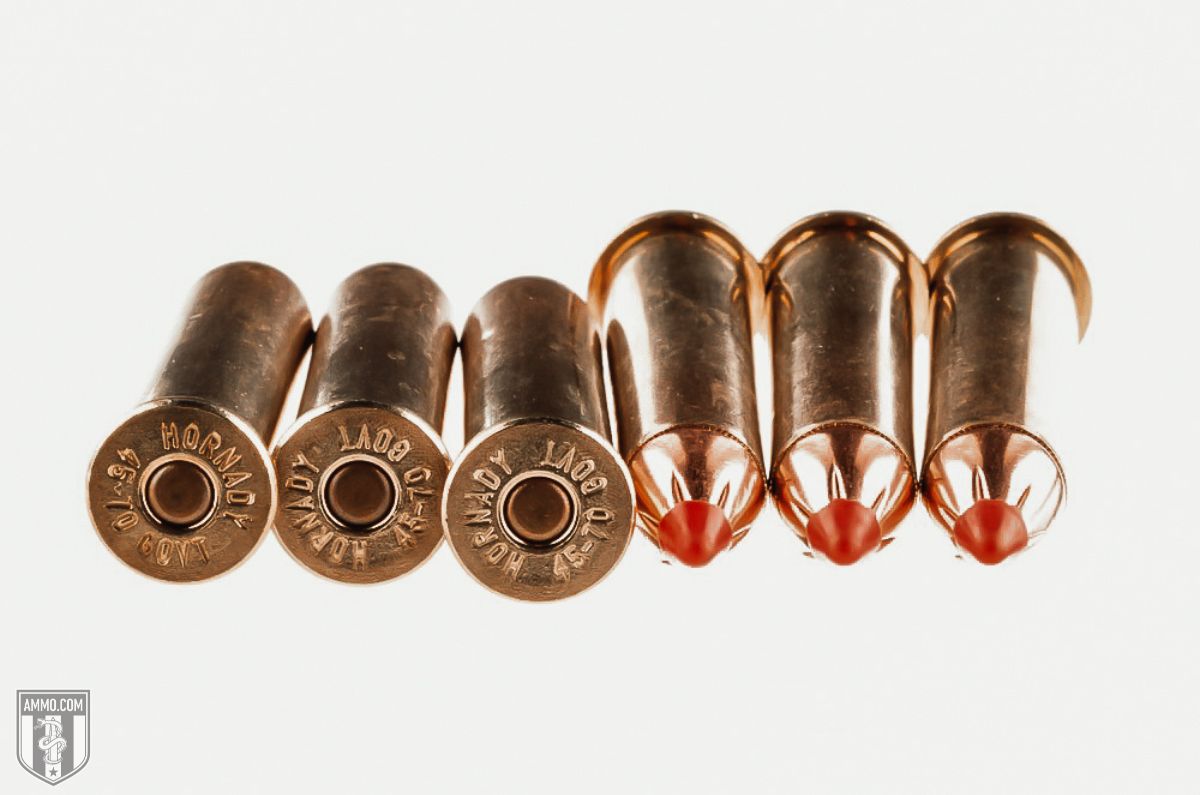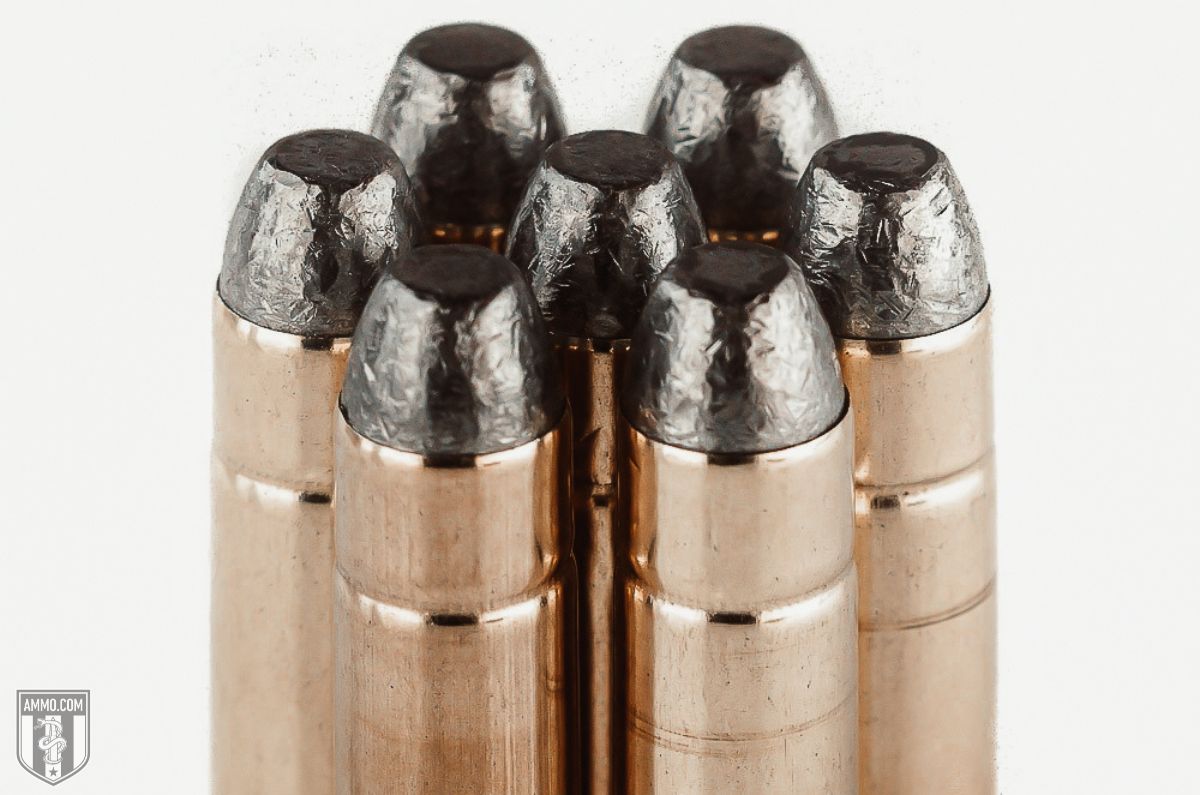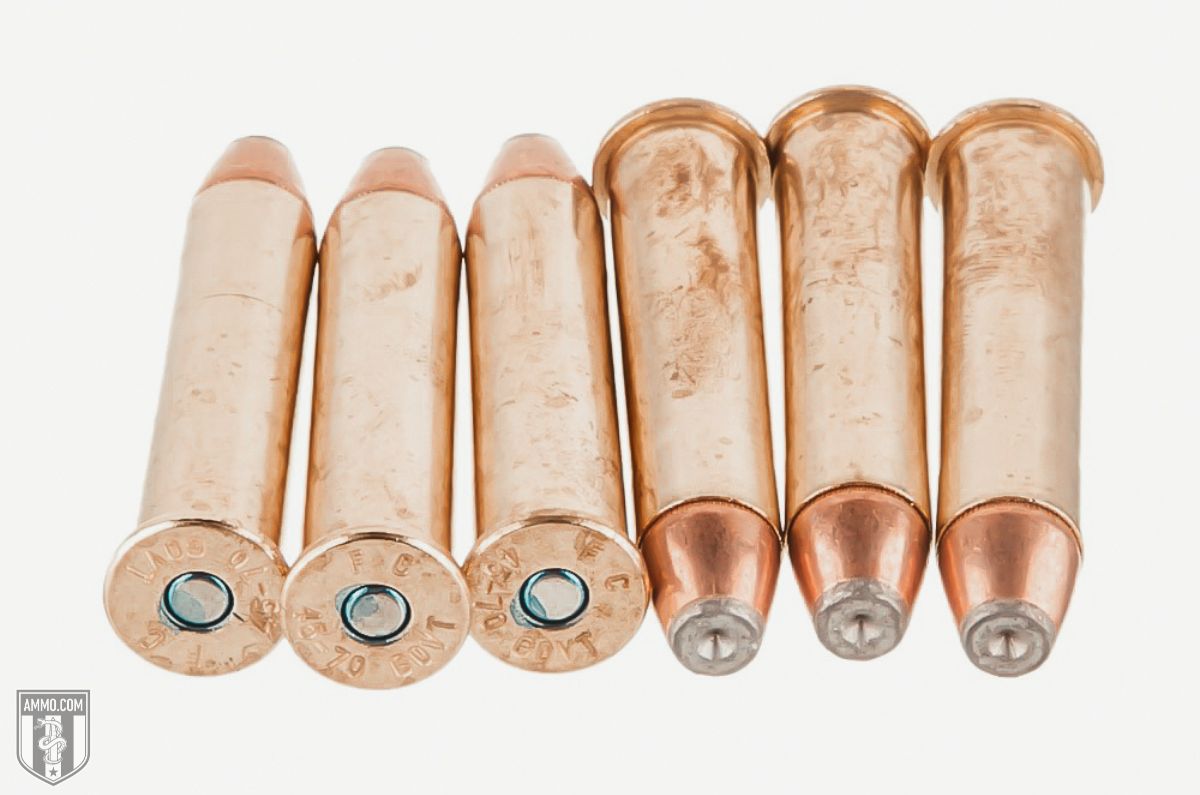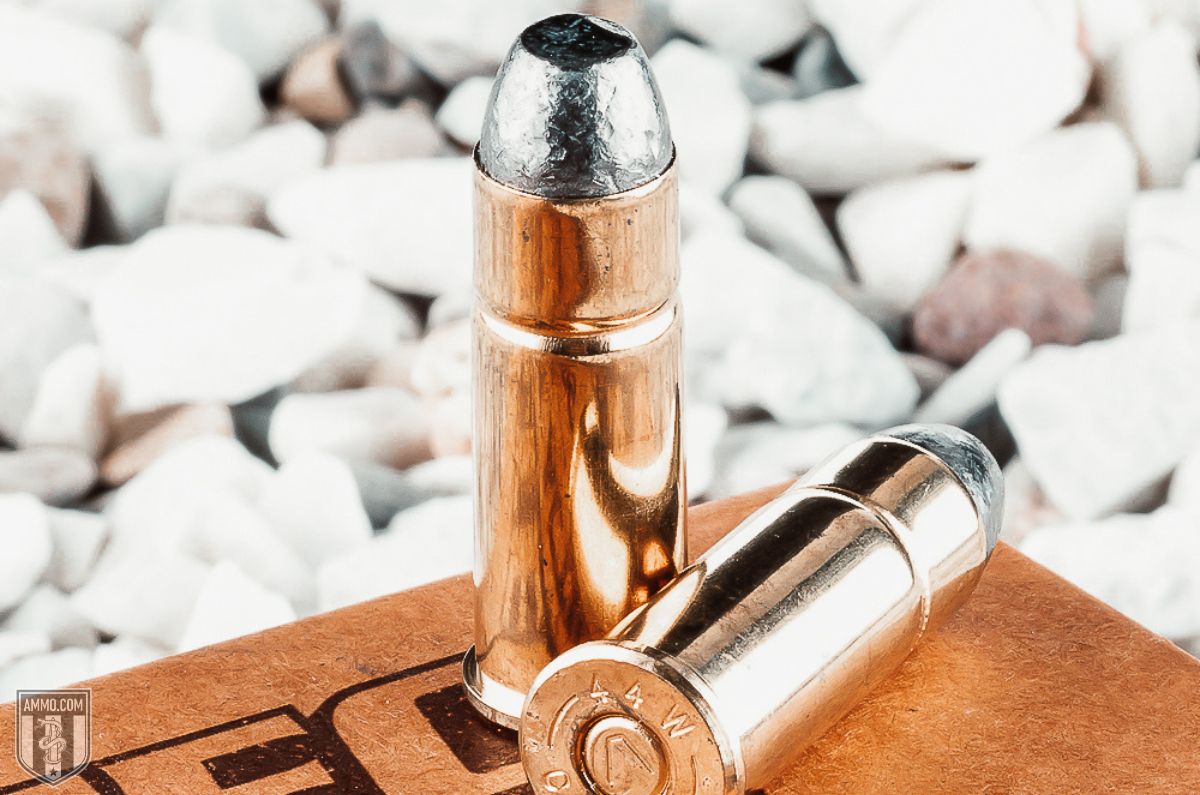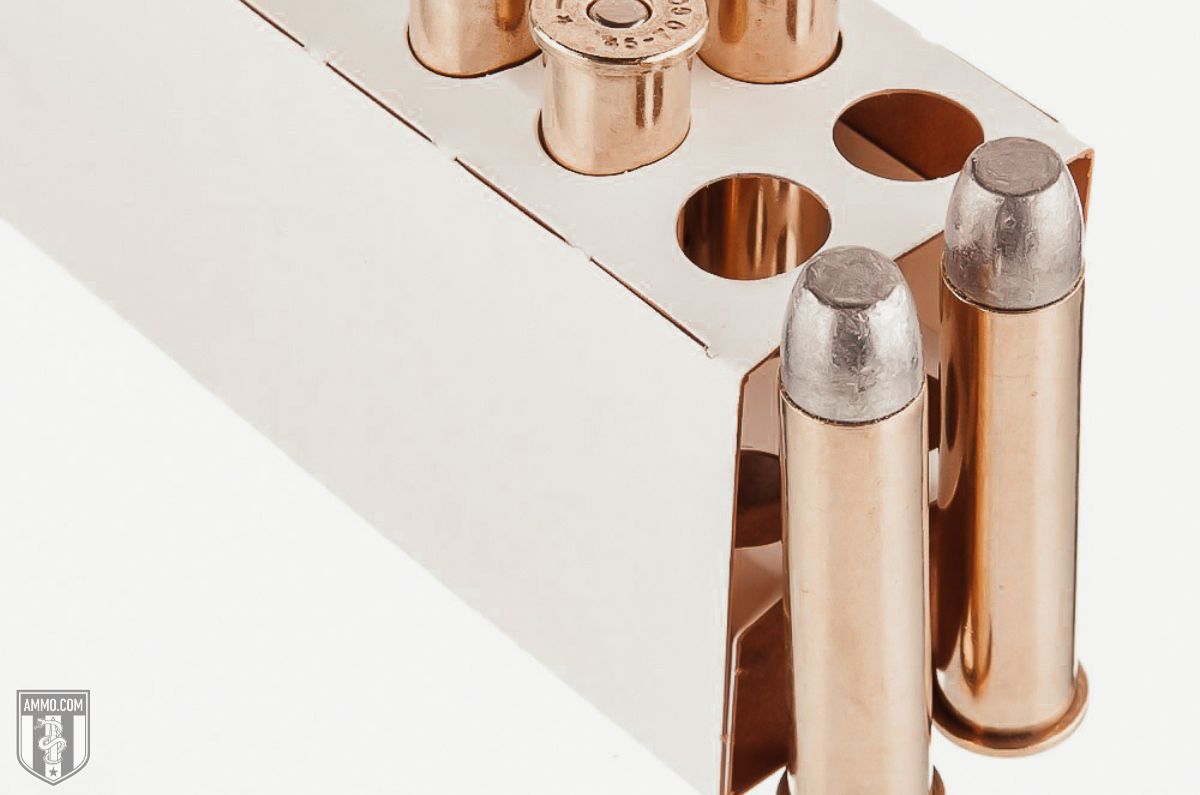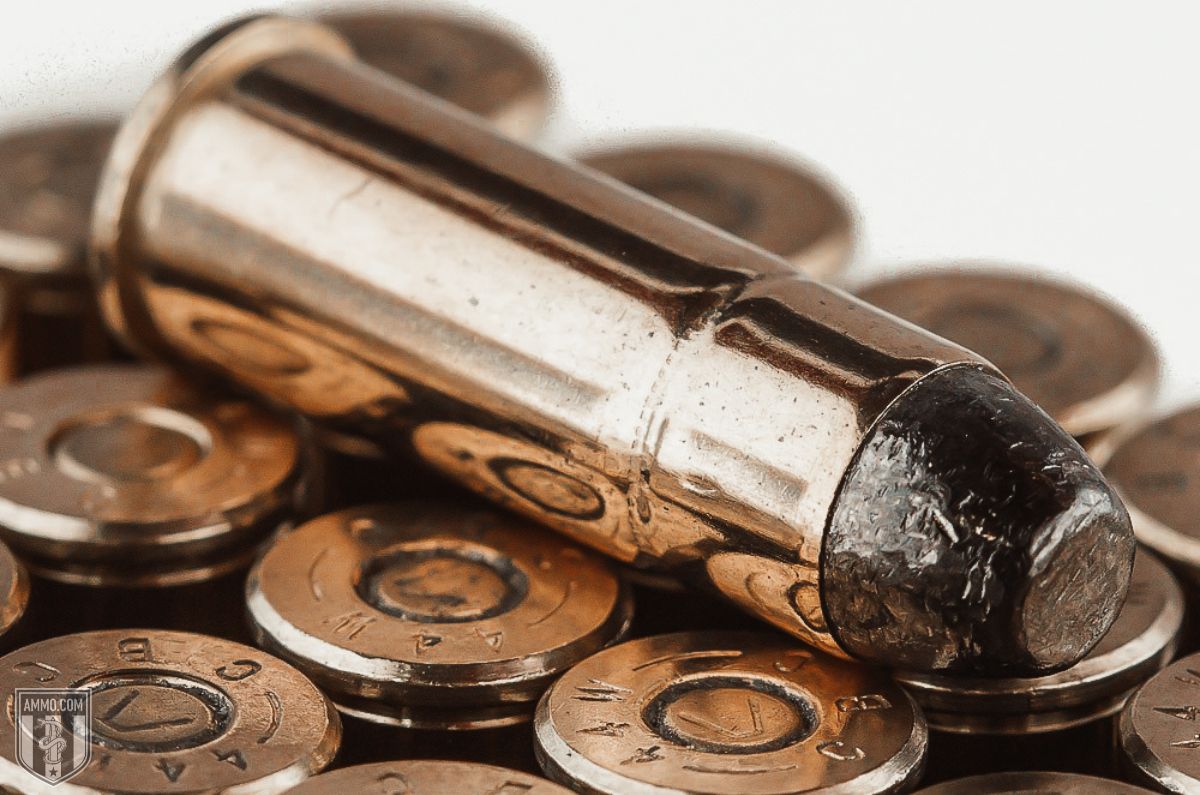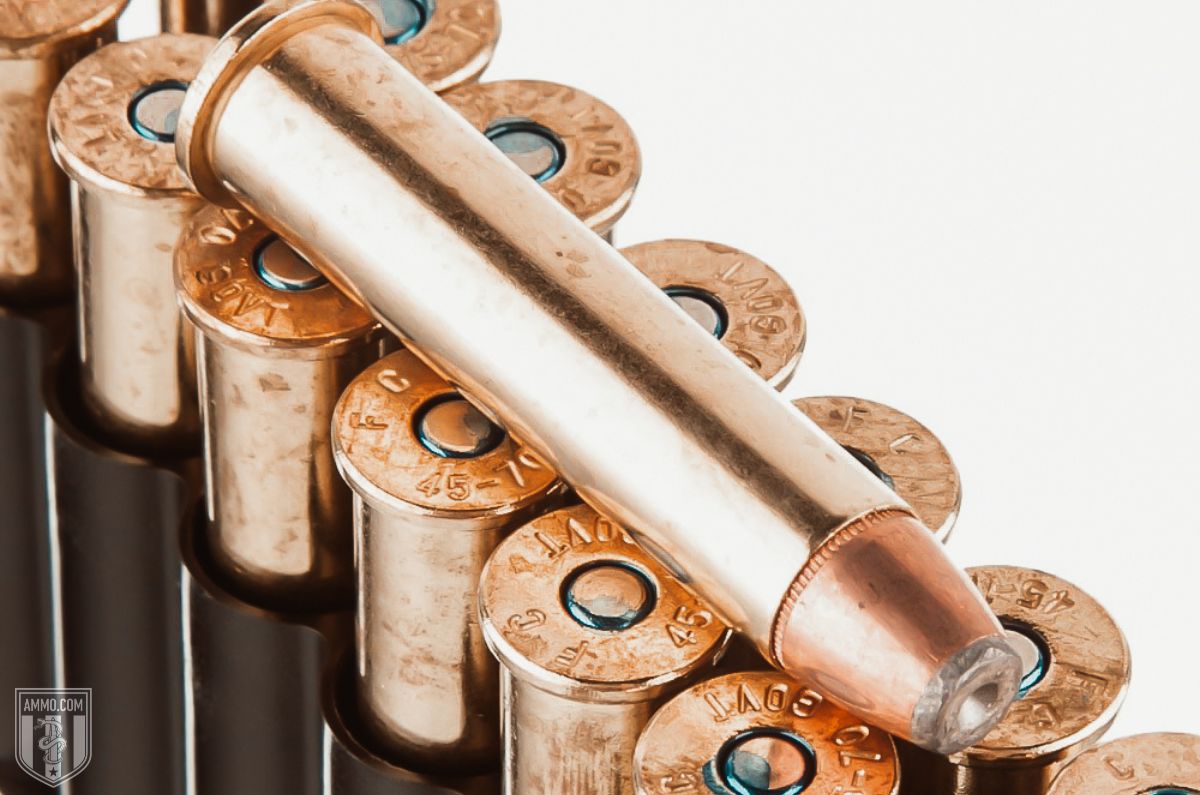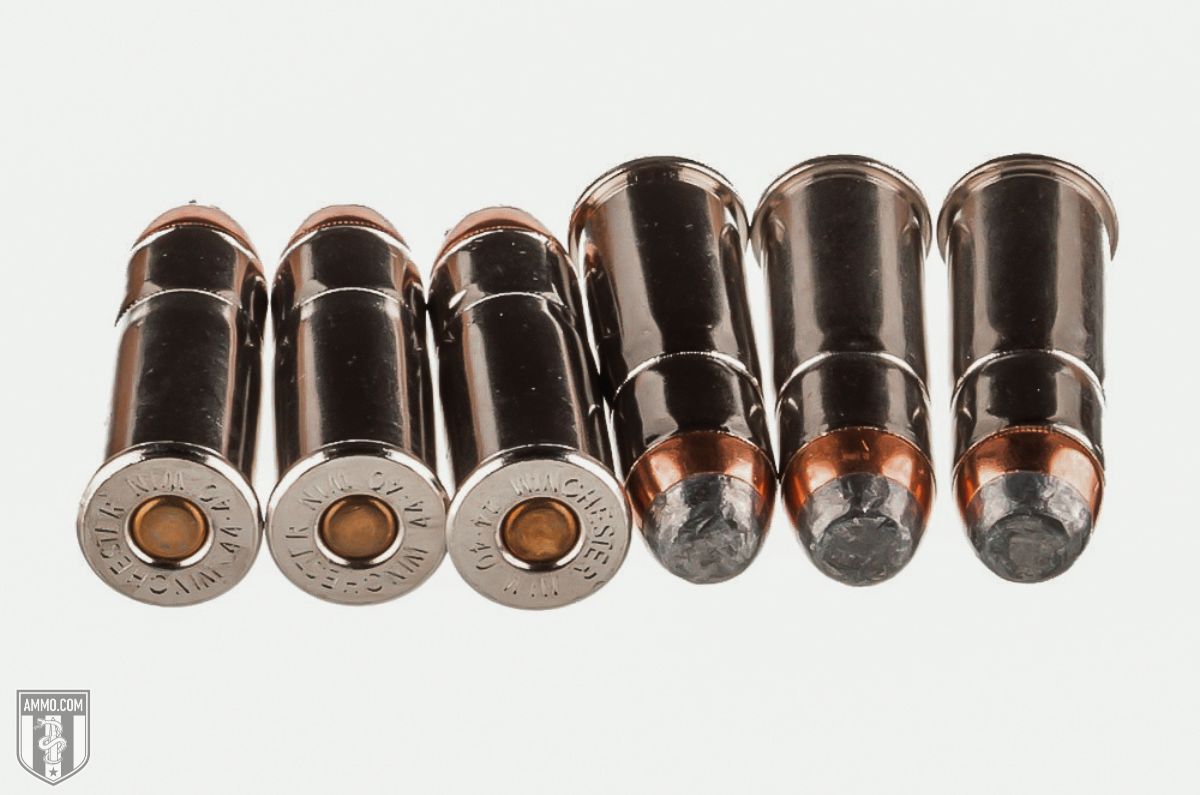44 40 vs 45 70: The Cartridges That Won the West
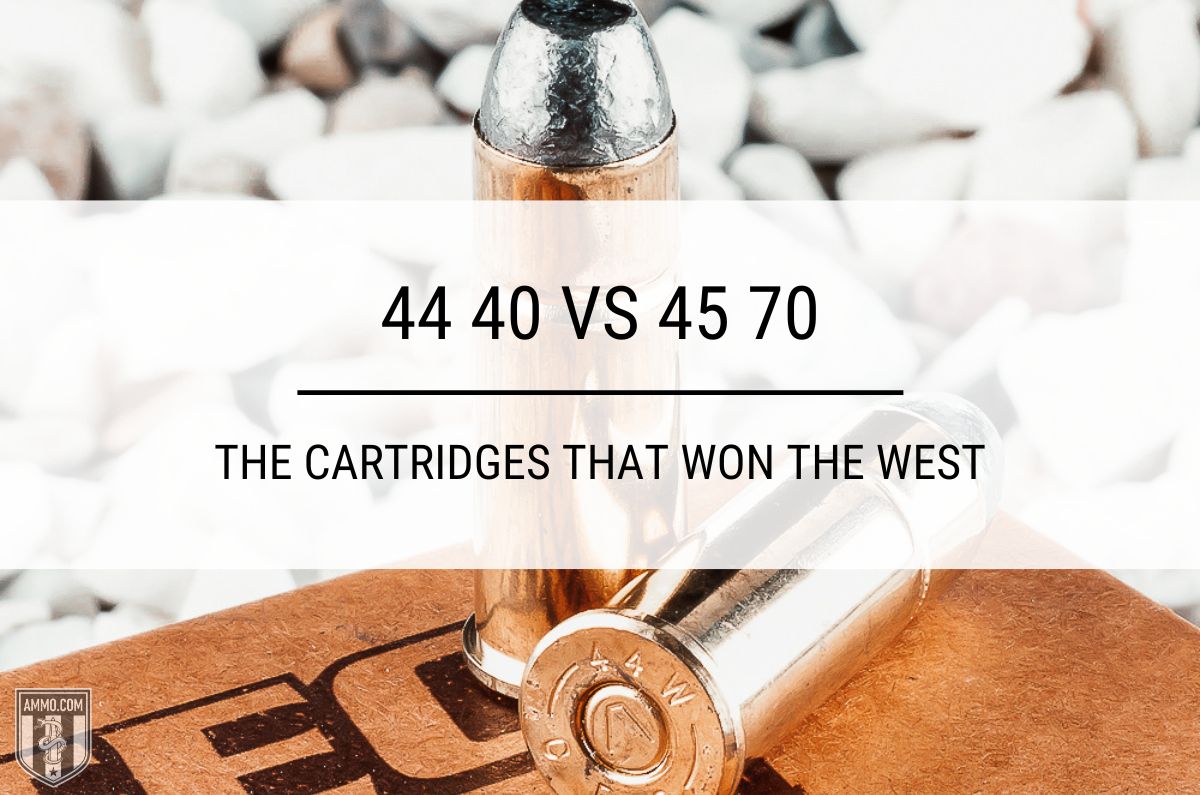
The 45-70 Government and 44-40 Winchester are two centerfire cartridges that emerged shortly after the end of the American Civil War and are widely accepted as two of the most potent hunting cartridges of that era.
The 45-70 outperforms the 44-40 in virtually every ballistic category as the 44 40 cartridge was developed as a handgun round and the 45 70 as a rifle round. To put it bluntly, these two cartridges simply do not compare as the 45-70 is vastly more powerful than the 44-40.
However, this is not to say that the 44-40 Win does not have its place in the shooting world, as it has seen a resurgence of popularity in the metallic silhouette and cowboy action shooting competitive circles.
How then is a modern greenhorn to choose between these two cowboy rounds? Should they invest in a classic 45-70 lever action rifle or is the 44 40 cartridge good enough?
In this article, we will evaluate the 44 40 vs 45 70 Government to help you understand the differences between the two and give you a clearer understanding of which cartridge is best for your shooting and big game hunting needs.
What is the difference between the 44 40 and the 45 70?
The primary difference between 44 40 Winchester and 45 70 Government is that the 44-40 is a handgun round while the 45-70 is a rifle cartridge. Furthermore, the 44-40 uses a bottle-necked cartridge case while the 45-70 utilizes a straight-walled case design.
Cartridge Specs
When evaluating centerfire cartridges, it’s a good idea to analyze the cartridge specs to gain more knowledge of each.
Both rounds were released in 1873 as part of a metallic cartridge renaissance after the close of the Civil War. Neither round has a parent case, as each one was a completely novel design.
The 44-40 Winchester Center Fire (WCF) was developed by Winchester Repeating Arms and was the first metallic cartridge ever offered by the company. The round was extremely popular upon release, causing Marlin and Remington to offer rifles and revolvers chambered in 44-40 in short order.
However, perhaps the most famous firearm chambered in 44-40 was the Colt Single Action Army (SAA), otherwise known as the Peacemaker. Although originally chambered in 45 Colt, the SAA was offered in an alternative configuration for firing the 44-40.

In contrast, the 45-70 Government (or Govt for short) was developed by the U.S. Army’s Springfield Armory for their new Model 1873 single shot rifle, otherwise known as the Trapdoor Springfield.
Both rounds began their civilian and military service as a black powder cartridge, as such their naming convention is different than modern cartridges.
The original name for the 45-70 Govt was 45-70-405 and here’s what that means:
- 45: The cartridge fires a 0.458” diameter bullet
- 70: The powder charge is 70 grains of black powder
- 405: The bullet weight is 405 grains
The same convention applies to the 44-40, a 44-caliber bullet loaded with 40 grains of black powder.
One major visual difference between the 44 40 and 45 70 is the design of their cartridge case, as the 44-40 utilizes a bottle-neck design while the 45-70 Govt is a straight walled cartridge.
Another obvious visual difference when you stack these two rounds side-by-side is how much larger the 45-70 is compared to the 44-40. The 45-70 has a case length of 2.105” and overall length of 2.55” compared to 1.305” and 1.592” for the 44-40 WCF, respectively.
Not only is the 45-70 taller, but it is also wider than the 44-40 as the 45 70 Govt has a base diameter of 0.505” compared to 0.471” for the 44 40 Win.
With such a larger case, it’s not surprising that the 45-70 has considerably more case capacity than the 44-40. And by more, I mean over 2x more! The 45-70 Government has a case capacity of a whopping 81.8 gr compared to 40 gr for the 44-40 Win.
Although the case capacity of the 45-70 is twice that of the 44-40, both rounds have a relatively low maximum chamber pressure. As both rounds were developed to fire black powder loads, they weren’t designed for the higher pressures that come with smokeless powder.
Per SAAMI specs, the 45 70 has slightly higher maximum pressure limits at 28,000 psi compared to 22,000 psi for the 44-40.
The final, and perhaps most obvious, difference between these two cowboy rounds is that the 45-70 fires a 0.458” bullet diameter while the 44-40 has bullet diameter of 0.427”.
This means that the 45-70 will generally fire heavier bullets than the 44-40. With double the case capacity, the 45-70 can fire extremely heavier bullets with weights ranging from 250 grains up to 500 grains. On the other hand, the 44-40 was developed to fire lead round-nose, flat-point 200 grain bullets but can fire projectiles up to 225 grains in weight.
It’s important to note that the 44-40 was initially developed as a revolver cartridge that was adapted to lever-action carbines and rifles so settlers and lawmen could carry the same cartridge for multiple firearms. On the other hand, the 45-70 was developed exclusively as a high-powered military rifle cartridge that smoothly transitioned into a big game hunting role.
These distinctions are important to remember in the following ballistic comparisons, as the 45-70 and its massive case capacity will outstrip the 44-40 in virtually every category.
Recoil
Recoil is an important consideration when purchasing a new rifle as a round with heavy recoil will be more difficult to control and will slow your rate of follow up shots. The potential for flinching is also an issue for cartridges with heavy recoil.
Felt recoil will differ from shooter to shooter and is often dependent on firearm choice, stance, and your chosen factory ammo or handloads. However, free recoil is a more objective measure of how hard a cartridge hits based on firearm weight, muzzle velocity, powder charge, and bullet weight.
It should come as no surprise that the 44-40 has considerably less recoil as the 45-70 fires heavier bullets and has double the case capacity.
For the purposes of this comparison, we will consider black powder loads for both cartridges, as comparing modern 45-70 smokeless loads to lower pressure 44-40 loads is a true apples to oranges situation.
For the 44-40, a standard lead round-nose, flat point 200 grain bullet traveling at 1,245 fps will be compared to the 405 gr 1,394 fps Trapdoor-safe black powder load for the 45-70.
The rifles in question will be the Winchester ’73 lever-action rifle for 44 WCF weighing 7.5 lbs and the Uberti replica Springfield Trapdoor carbine weighing 7.3 lbs.
Given these rounds and firearms, the 44-40 will have a free recoil of 8.5 ft-lbs while the 45-70 will have a free recoil of 36 ft-lbs. That’s over a 4x difference in terms of recoil!
Although the 45 70 Govt packs a heavier bullet and more powder, there’s a price to be paid in terms of recoil. For those shooters who are recoil sensitive, the 44-40 is clearly the best option when compared to the 45 70.
Muzzle Velocity, Kinetic Energy, and Trajectory
Thanks to its cavernous case capacity, the 45-70 outperforms the 44 WCF in every ballistic category. To evaluate these claims, we’ve selected three different rounds to compare their ballistic performance.
For the 45-70, the original black powder Trapdoor-safe load was selected, firing a 405 gr lead round nose, flat-point (RNFP) bullet as well as the Hornady LEVERevolution 325 gr FTX. The Hornady round was selected to display the differences between the original, low pressure round and modern 45-70 ammo.
For the 44-40 the original Winchester load was selected, a lead RNFP 200 grain bullet loaded with 40 grains of black powder.
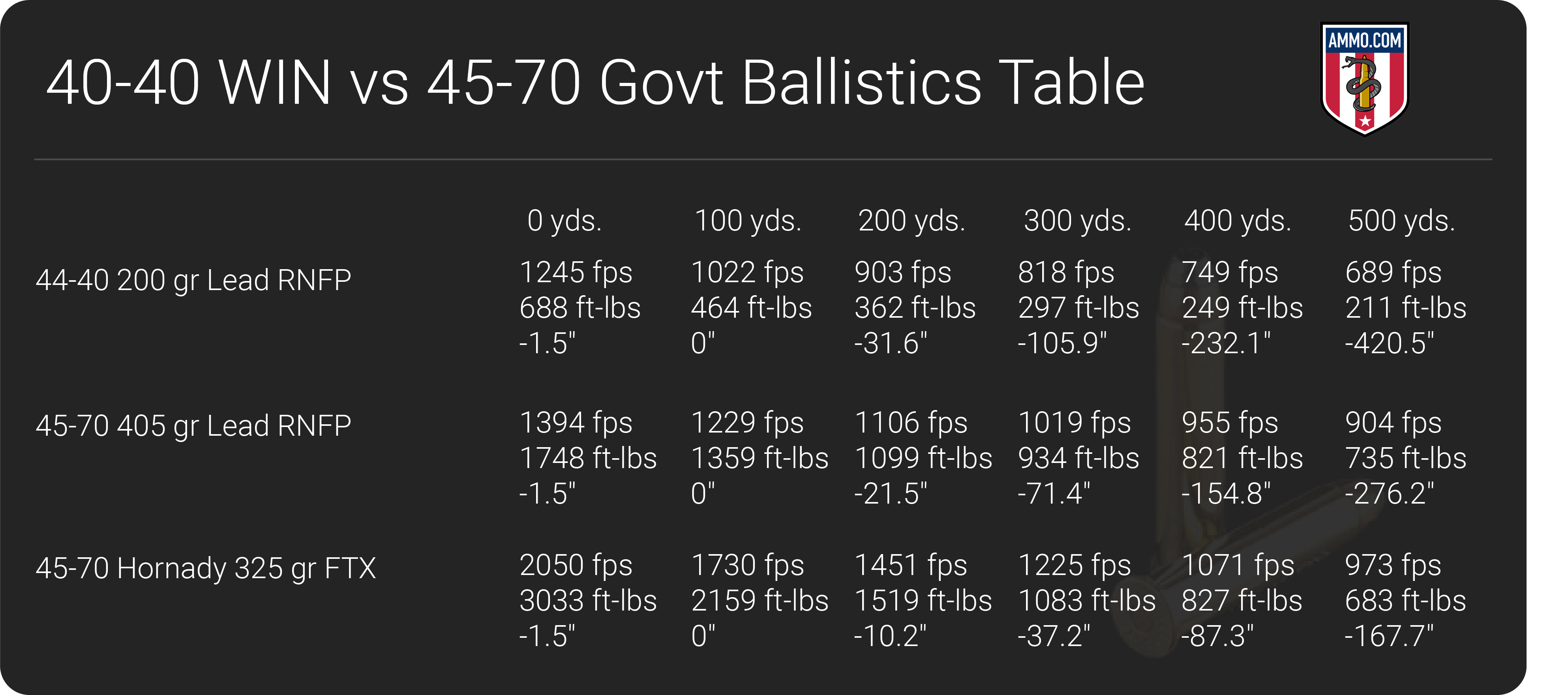
In terms of muzzle velocity, the two black powder loads were closer than expected. The 45-70 still is has slightly higher velocity than the 44-40 at 1,394 fps compared to 1245 fps. The modern 45-70 Hornady load completely obliterates both black powder cartridges at 2,050 fps, showcasing how impressive modern high velocity 45-70 ammo can be.
For kinetic energy, the 44 WCF doesn’t even live on the same planet as the 45-70 Government. As a handgun round, the 44-40 is very impressive, as it has nearly 50% more kinetic energy than a modern 40 S&W defensive load.
However, the 45-70 has well over 2.5x the muzzle energy of the 44-40 at a whopping 1,748 ft-lbs compared to 688 ft-lbs. The modern 45-70 Hornady factory ammo nearly doubles the muzzle energy of the black powder load with a bone shattering 3,033 ft-lbs of energy.
I feel a bit like a broken record at this point, but the 45-70 continues its domination with an incredibly flat trajectory when compared to the 44-40.
At 300 yards, the 45-70 black powder load has over 30% less bullet drop compared to the 44-40 Win at -71.4” compared to -105.9”, respectively. The 45 70 modern power load has nearly half that of the black powder 45-70 cartridge at -37.2”.
There’s no denying that the 45-70 is the superior cartridge in terms of ballistics. Even the older black powder loads for 45-70 simply outperform the 44-40 by leaps and bounds in terms of muzzle velocity, stopping power, and trajectory.
However, it’s also important to remember that we are comparing a revolver cartridge to a rifle cartridge, meaning these results should not be overly surprising.
Ballistic Coefficient and Sectional Density
Ballistic coefficient (BC) is a measure of how aerodynamic a bullet is and how well it will resist wind drift. Sectional density (SD) is a way to evaluate the penetration ability of a bullet based on its external dimensions, design, and weight.
The bullets fired by both cartridges are not very aerodynamic and therefore have generally lower BC values for their weight. The main issue is that these rounds are typically fired from lever-action rifles that utilize tubular magazines where the bullets are loaded end-to-end.
Therefore, the bullets used for a lever-action rifle must either be a round or flat nose design or hollow points. If a pointed, Spitzer style bullet was used it could impact the primer of the round in front of it in the magazine. This could set off a chain reaction that could seriously damage the firearm and/or shooter.
Hornady has attempted to remedy this situation with their Hornady LEVERevolution line of bullets. These pointed bullets are safe to use in a lever gun, as the tip is made of soft polymer that should not set off a primer when loaded into a tubular magazine.
At the time of writing, LEVERevolution ammo is not available in 44-40 Winchester.
In most cases, the 45-70 will have a higher BC and SD than the 44-40 for both black powder and modern factory ammo.
According to the 49th Edition Lyman Reloading Manual, a lead 405 gr RNFP for 45-70 will have a BC of 0.307 and SD of 0.276. In contrast, a lead RNFP 200 grain bullet for 44-40 will have a BC of 0.149 and SD of 0.155.
The 45-70 Government is unquestionably the longer-range shooting cartridge with its higher ballistic coefficient and will penetrate deeper than the 44-40 based on its higher sectional density values.
Hunting
The 45-70 Government can take virtually any game animal on the planet with proper loads.
The 45-70 has claimed countless whitetails and elk across North America and is often found loaded with hard cast lead bullets for use in a guide gun deep in bear country.
The ability of the 45-70 to seamlessly transition from shooting cast bullets to jacketed bullets gives it a wide range of versatility not seen in other cartridges.
Furthermore, the 45-70 packs enough stopping power to put down the orneriest grizzly bear and even a cape buffalo with proper shot placement.
This is not to say that the 44-40 Winchester is an ineffective hunting round. Many hunters claim that the 44-40 has taken more whitetail than any other round, save the 30-30 Win.
However, the question of ethical hunting come up when considering hunting with the aged 44 WCF. The 44-40 lacks the kinetic energy that most hunters agree is the minimum for whitetail, which is 1,000 ft-lbs.
This is not to say that this is required, as many deer are felled at the hands of rimfire shooters every year. However, just because you CAN do something does not mean that it is the BEST option.
Taking an older Henry Iron Frame or Winchester Model 1873 chambered in 44-40 out into the deer stand has a certain mystique about it. Not only does hunting with an older cartridge offer more of a challenge, but it also gives a hunter a greater connection with their ancestors and those hunters who braved to uncharted territories of the Wild West.
However, with so many other great lever-action calibers available for deer hunting, it’s hard to justify using an underpowered round like the 44-40 on anything larger than coyotes. If you need a low recoil option for deer, lever guns chambered in 44 Magnum and 30-30 would make a better choice.
In a pinch or a SHTF scenario, sure the 44-40 will get the job done on a deer with proper shot placement. However, so long as society is still intact or you aren’t fighting for survival, the 44-40 just doesn’t have the stopping power needed to ethically harvest a whitetail.
Ammo and Rifle Cost/Availability
The 45-70 is considerably more popular than the 44-40, meaning that there are many more ammo and rifle options available for the 45 70.
There is little question that the 45-70 Government is the second most popular black powder round on the market, surpassed only by the 45 Long Colt cartridge.
The strength of the 45-70’s cartridge case allowed it to transition from black powder to smokeless powder and jacketed bullets extremely smoothly. Furthermore, as metallurgy and firearm manufacturing techniques strengthened receivers, the power level of the 45 70 increased in kind.
This cannot be said of the 44-40, as older firearms lack the strength needed to fire hard cast or jacketed bullets, as doing so can create pressure spikes that these antiques cannot handle.
In addition, as time passed on and newer cartridges began to gain popularity, the 44-40 mostly fell by the wayside and became obsolete. It wasn’t until recently that the cowboy action shooting scene started to pick up the 44-40 and some interest in the cartridge was revitalized.
When it comes to ammo variety, the 45-70 claims nearly a 5:1 advantage over the 44-40.
All the major ammo manufacturers like Hornady, Federal, Winchester, Remington, Barnes, and Fiocchi have some variety of 45-70 available. Buffalo Bore in particular has multiple varieties of ammo for 45-70 Govt that cover the entire spectrum of pressures fired by 45 70 rifles.
For low pressure rounds or inexpensive plinking ammo, 45 70 will cost around $2.50/round while premium hunting ammo ranges between $3 and $6/round.
In contrast, there are only a few ammo manufacturers who currently offer factory ammo for 44-40. Hornady, Winchester, Magtech, Buffalo Bore, and Black Hills are the primary suppliers of ammo at the time of writing.
In terms of cost, Black Hills plinking ammo is the least expensive around $1.15/round while Buffalo Bore loads fetch prices closer to $3.25/round. This is not entirely unexpected as the 44-40 requires less raw materials to produce as it is smaller than the 45 70.
As both of these cartridges are rimmed, lever-action rifles are the primary firearm for both rounds. There are some single shot rifles available for 45-70, but in general a lever gun is your primary option.
The Ruger-Marlin 1895, Browning 1886, and Winchester Model 1886 are all excellent lever gun options for the 45-70. In contrast, the Henry “New Original Iron Frame”, Rossi 92, Winchester Model 1894, and Winchester ’73 are all excellent options for 44-40.
Since the 44-40 was developed as a revolver cartridge, there are more handgun options for it than there are for 45-70. The Ruger Vaquero, Colt SAA, Uberti Cattleman, and Colt Frontier Single Six are all excellent revolver option for the 44-40.
If you fancy yourself a “recoil junkie” and want a revolver in 45-70, there is one option available in the Magnum Research BFR.
Rifles chambered in 45-70 are generally more expensive as they require more materials and heavier receivers than those needed for the 44-40. However, it will generally be easier to acquire a 45-70 lever gun at your local sporting goods store than one chambered in 44-40.
Reloading
Reloading is one method shooters use to reduce their overall cost per round and increase the consistency of their ammo. Furthermore, handloads can be tailored to your rifle to meet your specific shooting needs.
Bullets and powder will be relatively easy to come by, as handloaders have been making reloads for these rounds for well over a century. However, take care when ordering bullets to ensure that you are ordering the correct bullet diameter, 0.458” for 45 70 and 0.427” for 44-40.
It should also be noted that only cast lead bullets should be used for 44-40, as their older barrels and receivers are not equipped to handle higher pressure that accompany hard cast or jacketed bullets.
The 45-70 can hand bullets of all different coatings, from bare lead to full metal jackets and everything between.
If used in a lever-action rifle, do not forget that flat point bullets are the best option due the tubular magazines these rifles use.
Care also needs to be taken when handloading for the 45-70 to ensure that you are loading to appropriate pressures for your firearm. If you are not sure what pressures your 45-70 rifle can handle, seek the services of a qualified gunsmith.
Sourcing brass for 45-70 will typically be easier as the round is more popular than the 44-40. Winchester and Starline still produce factory new 44-40 brass if you can find it, otherwise you’ll need to keep your once-fired brass or look to the secondary market for used cases.
Final Shots: 45 70 vs 44 40
The 44-40 Winchester and 45-70 Government represent two of the most successful black powder cartridges from the post-Civil War Era. Both cartridges come with a rich heritage and were extremely successful at winning the West.
The 45-70 Government is a big game hunting cartridge that has survived the test of time and successfully bridged the gap between black powder and smokeless powder. As one of the oldest cartridges still in circulation, the 45-70 simply will not die due to its ability to scale in power level to the strength of the rifle firing it.
The 44-40 Winchester is a revolver cartridge that is credited for being the top whitetail hunting cartridge of its day. Although it has faded into relative obscurity until recently, the 44-40 allowed cowboys, ranchers, and settlers to have one type of ammo for their sidearm and rifle. That type of flexibility and utility is something that defined America during this time.
Although the 44-40 has drastically lower recoil than the 45-70, most shooters will choose the 45-70 for its improved ballistic performance, ammo availability, and sheer stopping power.
Many hunters and shooters won’t find that they have a need for a 44-40 rifle, as more modern cartridges like the 30-30 Win offer drastically improved ballistics with only a small increase in recoil.
However, if you WANT a 44-40, you should not stop yourself from getting one as factory ammo is still available and reloading components are relatively easy to come by.
No matter which cartridge you choose, make sure you stock up on ammunition here at Ammo.com and I’ll see you on the range!
Ammo Comparisons
- .308 vs 5.56
- 6.5 Creedmoor vs .308
- .300 Blackout vs .308
- .300 Win Mag vs .308
- .243 vs .308
- .308 vs .30-06
- 7mm-08 vs .308
- .270 vs .308
- 7.62x39 vs .308
- .223 vs .308
- .338 Lapua vs .308
- .380 ACP vs 9mm
- .223 vs 5.56
- .300 Blackout vs 5.56
- 9mm vs 45 ACP
- 9mm vs 40 S&W
- .357 SIG vs 9mm
- 10mm vs 9mm
- 9mm vs 9mm Luger
- .243 vs .270
- .300 Win Mag vs .30-06
- .270 vs .30-06
- .40 vs .45
- 38 Special vs 357
- 9mm vs 40 vs 45
- 5.56 vs 7.62x39
- 338 Lapua vs .30-06
- .30-30 vs .30-06
- 300 PRC vs 338 Lapua
- .30-06 vs 7mm
- 300 Win Mag vs 338 Lapua
- 300 PRC vs 300 Win Mag
- 300 WSM vs 300 Win Mag
- 338 Win Mag vs 338 Lapua
- 12 Gauge vs 20 Gauge
- 10mm vs 357 Mag
- .30-30 vs 7.62x39
- 224 Valkyrie vs 22-250
- 17 HMR vs 22 Mag
- 7.62x39 vs .300 Blackout
- 45 ACP vs 45 Auto
- 45-70 vs 30-30
- 300 Blackout vs 223
- 357 Magnum vs 9mm
- 350 Legend vs 300 Blackout
- 224 Valkyrie vs 223
- 45 ACP vs 38 Super
- 6.5 Grendel vs .308
- 17 HMR vs 22 LR
- 10 Gauge vs 12 Gauge
- 22-250 vs 223
- 45 Colt vs 45 ACP
- 350 Legend vs 30-30
- 5.7x28 vs 223
- 5.7 vs 9mm
- 5.56 vs 5.7
- 22 vs 9mm
- Buckshot vs Birdshot
- 450 Bushmaster vs 308
- 450 Bushmaster vs 223
- Buckshot vs Slug
- 6.5 Grendel vs 5.56 vs 223
- 6mm ARC vs 6.5 Grendel
- 44 vs 45
- 458 SOCOM vs 5.56
- 357 vs 44
- 32 ACP vs 380
- 300 Win Mag vs 338 Win Mag vs 338 Lapua Mag
- 450 Bushmaster vs 458 SOCOM vs 50 Beowulf
- 6mm Creedmoor vs 6.5 Creedmoor
- TMJ vs FMJ
- 44 Special Vs 44 Magnum
- 45 90 vs 45 70
- 6.8 Western vs 6.8 SPC
- 50 Beowulf vs 50 BMG
- 26 Nosler vs 6.5 PRC
- 28 Gauge vs 410
- 6.8 SPC vs 5.56
- 6.8 SPC vs 6.5 Grendel
- 6.8 Western vs 7mm Rem Mag vs .28 Nosler
- 6.8 Western vs 6.5 Creedmoor
- 22 Hornet vs 223
- 6.8 Western vs 6.5 PRC
- .410 vs 12 Gauge
- .410 vs 20 Gauge
- 22 LR vs 22 Mag
- 6mm ARC vs 243
- 7mm-08 vs 270
- 243 vs 6.5 Creedmoor
- Nickel vs Brass Casing
- 204 Ruger vs 223
- 50 Beowulf vs 5.56
- 260 Remington vs 6.5 Creedmoor
- 6mm Remington vs 243
- 28 Nosler vs 300 PRC
- 50 Beowulf vs 50 AE
- 22 Nosler vs 22-250
- 450 Marlin vs 45-70
- 300 Win Mag vs 300 Norma
- 458 SOCOM vs 300 Blackout
- 38-55 vs 45-70
- 22 Hornet vs 22 LR
- 300 Norma vs 338 Lapua
- 338 Lapua vs 50 BMG
- 28 Nosler vs 300 Win Mag
- 28 Nosler vs 6.5 Creedmoor
- 204 vs 22-250
- 458 SOCOM vs 45 70
- 44 40 vs 45 70
- 6.8 SPC vs 6.5 Creedmoor
- 450 Bushmaster vs 30-06
- 7mm Rem Mag vs 300 Win Mag
- 30 Carbine vs 223
- 25-06 vs 30-06
- 26 Nosler vs 28 Nosler
- 16ga vs 12ga
- 30 06 vs 7.62 x54R
- 9mm Makarov vs 9mm Luger
- 350 Legend vs 223
- 30 Carbine vs 5.56
- 6.5x55 vs 6.5 Creedmoor
- 6.5 Creedmoor vs 270 vs 25-06
- M193 vs M855
- 450 Bushmaster vs 458 SOCOM
- 6.5 Grendel vs 6.5 Creedmoor
- 350 Legend vs 5.56
- .277 Fury vs 6.8 SPC
- 277 Fury vs 300 Win Mag
- 10mm vs .45 ACP
- 277 Fury vs 223
- 6.8 SPC vs 300 Blackout
- 6.5 PRC vs 6.5 Creedmoor
- 277 Fury vs 308
- 277 Fury vs 6.5 Creedmoor
- 350 Legend vs 450 Bushmaster
- 277 Fury Vs 5.56 NATO
- 10mm vs 40S&W
- 32 ACP vs 9mm
- 32 Special vs 9mm
- 8.6 Blackout vs 300 Blackout
- 30 Super Carry vs. 9mm
- 5.56 vs 9mm
- .50 Action Express vs 9mm
- 7.62x25 vs. 9mm
- 10mm vs 44 Magnum
- 300 Blackout vs 300 Win Mag
- 6.5 Grendel vs 300 Blackout
- 460 Rowland vs 10mm
- 300 RUM vs 300 PRC
- 300 Norma vs 300 PRC
- 45 GAP vs 45 ACP
- 7mm PRC vs 300 Win Mag
- 300 PRC vs 6.5 Creedmoor
- 300 PRC vs 308
- 357 SIG vs 357 Mag
- 7.62x39 vs 7.62x51
- 243 Win vs 223 Rem
- 30 Nosler vs 300 PRC
- 6.5 Creedmoor vs. 30-06 Springfield
- 450 S&W vs. 44 Magnum
- 6.5 Creedmoor vs. 300 Win Mag
- 454 Cassull vs. 45-70 Govt
- 454 Cassull vs. 44 Mag
- 7.62x54r vs. 308 Winchester
- 22 ARC vs. 223 Rem
- Subsonic vs. Supersonic Ammo
